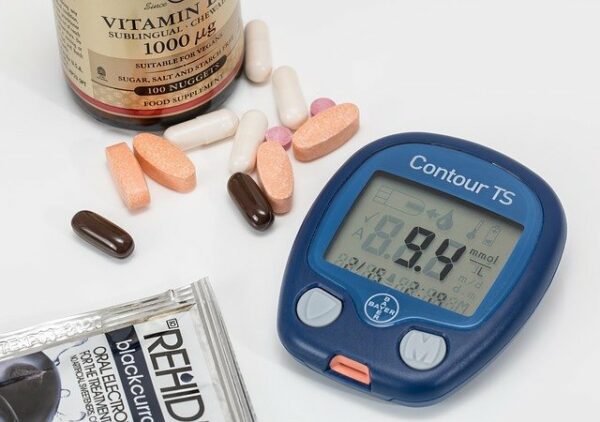While Dipeptidyl Peptidase-4 (DPP4) inhibitors aren’t used incredibly often, we wanted to provide a comparison of DPP4 inhibitors. DPP4 inhibitors are used in the treatment of diabetes and function by inhibiting the breakdown of endogenous incretin hormones GLP-1 and GIP, increasing their concentrations in the bloodstream. This will then stimulate insulin release and inhibit glucagon release, as well as reducing hepatic glucose production. You can typically expect around a 0.4-0.9% A1C decrease from these agents. DPP4 inhibitors have a similar mechanism of action to GLP-1 receptor agonists (RA), and should not be used concomitantly with them. This class is made up of the oral medications sitagliptin (Januvia), saxagliptin (Onglyza), linagliptin (Tradjenta), and alogliptin (Nesina). They are often combined with other antidiabetic medications, typically metformin. Other DPP4 inhibitors that are not available in the United States include anagliptin, gemigliptin, teneligliptin, evogliptin, omarigliptin, trelagliptin, and vildagliptin. Only the agents available in the US will be compared in the table found below.
Where do DPP4 inhibitors fit in the treatment recommendations for diabetes? Behind metformin, which is always first-line unless contraindicated, SGLT2 inhibitors, and GLP-1 agonists, they are an option when there is a compelling need to minimize hypoglycemia or to reduce the risk of weight gain. Linagliptin and sitagliptin have not demonstrated greater risk in patients with ASCVD, CKD, or HF. Linagliptin and sitagliptin are the two most common DPP4 inhibitors that I have seen used in my practice with an occasional saxagliptin mixed in. Saxagliptin and alogliptin are not recommended in patients with HF. Saxagliptin caused a small, but statistically significant, increase in hospitalizations for heart failure. This was more likely in patients at higher risk for heart failure, and was not associated with increased mortality. Alogliptin was also found to have an increased risk of hospitalization for heart failure, though it was not statistically significant. The FDA currently has a warning for increased risk of heart failure on the labeling of both of these medications.
In our comparison of DPP4 inhibitors, we need to at least mention adverse effects. There isn’t much variety in the adverse effect profile of these agents. DPP4 inhibitors are typically well-tolerated, with a side effect profile similar to placebo. The FDA does warn about the potential for severe and debilitating joint pain that may occur anywhere from day 1 of treatment to years after beginning therapy. If this occurs, it may be necessary to discontinue therapy. Other serious but rare adverse events include acute pancreatitis and allergic reactions. Less serious adverse effects are mentioned in the table below for each of the medications.
When comparing DPP4 inhibitors, there are typically not many drug interactions to be concerned about. Some are mentioned in the table below. Additionally, if DPP4 inhibitors are used concomitantly with insulin or a sulfonylurea (SU), the dose of insulin or the SU will likely need to be reduced to minimize the risk for hypoglycemia.
Also worth mentioning is the dosing of these agents. Due to their function as an enzyme inhibitor, rather than having a direct effect on glucose homeostasis, doses greater than the recommended labeled dosing will be unlikely to have additional therapeutic benefit, as the DPP-4 enzymes will be totally inhibited. Higher doses may leave patients at a greater risk of adverse effects, however.
One drawback of DPP4 inhibitors is cost; these agents are often more expensive than other oral options and cost around $200-220 monthly. This may limit their use in some patients with diabetes, but for those who are able to afford it, DPP4 inhibitors are an effective and well-tolerated medication and can also be a nice option for patients who are resistant to starting an injectable medication.
| Medication | Sitagliptin | Saxagliptin | Linagliptin | Alogliptin |
| Dose | 100 mg once daily | 2.5 mg or 5 mg once daily | 5 mg once daily | 25 mg once daily |
| Dose Adjustments | CrCl 30-50 mL/min: 50 mg dailyCrCl <30 mL/min: 25 mg daily | CrCl <45 mL/min: 2.5 mg daily | No renal dose adjustments necessary | CrCl 30-60 mL/min: 12.5 mg dailyCrCl 15-30 mL/min: 6.25 mg dailyNot recommended in severe hepatic impairment |
| Drug interactions | May increase digoxin levels, monitor during concomitant therapy | Strong CYP3A4/5 inhibitors: dose reduction (2.5mg) recommended | CYP3A4 or P-gp inducers: exposure may be reduced to subtherapeutic levels | No major drug interactions |
| Common Side Effects | May cause headache and URI | May cause URI, headache, and UTI | May cause cough, URI, and diarrhea | May cause headache or URI |
Hopefully, you found this comparison of DPP4 inhibitors helpful. Here’s a comparison of GLP-1 Agonists (updated in 2020) that you may find helpful.
This article was created by Lincoln Haiby, PharmD Candidate in collaboration with Eric Christianson, PharmD, BCPS, BCGP
- 30 medication mistakes PDF
- 18+ Page Drug Interaction PDF
- 10 Commandments of Polypharmacy Webinar based on my experiences in clinical practice
Study Materials and Resources For Healthcare Professionals and Students – Amazon Books
References:
Deacon, C.F. and Lebovitz, H.E. (2016), Comparative review of dipeptidyl peptidase-4 inhibitors and sulphonylureas. Diabetes Obes Metab, 18: 333-347. Accessed July 19, 2021.
FDA Drug Safety Communication: FDA warns that DPP-4 inhibitors for type 2 diabetes may cause severe joint pain. (2015). Accessed July 20, 2021.
Alogliptin Benzoate. Micromedex DrugDex. IBM Micromedex. Accessed July 20, 2021.
Linagliptin. Micromedex DrugDex. IBM Micromedex. Accessed July 20, 2021.
Saxagliptin Hydrochloride. Micromedex DrugDex. IBM Micromedex. Accessed July 20, 2021.
Sitagliptin Phosphate. Micromedex DrugDex. IBM Micromedex. Accessed July 20, 2021.



0 Comments